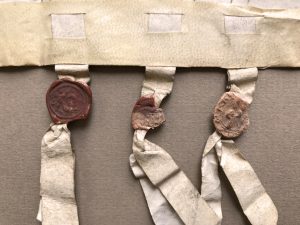New Acquisition: Medieval Deed
The library has recently acquired a Medieval deed recording the sale of a parcel of land in Norfolk that will aid students and researchers interested in the study of the history of law and land-holding in Western Europe.
This document is a type of late Medieval land deed called a feoffment which records the sale of real land or structures between two parties. These types of deeds were born out of the feudal system of land holding in England where a vassal was granted possession of a lord’s land (a fief) in exchange for service and the serfs, peasants who lived on the land, in turn served the land-holders. When granting a fief a vassal promised an oath of fealty, from the Latin fidelitas or fidelity, which included military or non-military service to the lord.
A 15th century feoffment has the following defining characteristics: first, the transfer retains the language of the earlier feudal era where land ownership was bestowed in fief, now of a fee, through land rights granted by Crown. As previously stated, the transfer of these land rights was based on service, but after the Middle Ages they became transferrable through monetary purchase. For example, a feoffment defines the condition of the exchange as “of the chief lord of the fee” or de capitalibus dominis feodi. Often, these deeds refer to a ceremonial exchange between parties called “livery of seisin,” where a physical piece of the land sold was exchanged between the two parties, such as a clod of dirt. Furthermore, though a feoffment recorded a sale, it did not specify the amount of money exchanged between the two parties for the land. Finally, wax seals were added by sellers involved the transaction, three in this instance, which was akin to having a document notarized today.
The newly acquired deed names the parties involved as: William Bokenham (of Weasenham), Alexander Webster (Weasenham), and John Golle (of Beeston) and the transfer of land to John Costyn, a dyer, Geoffrey Heye, and Thomas Wryghte and their heirs. The parcel of land sold was located in Weasenham, a parish in Norfolk, a shire county in the East of England.
The deed measures 93 x 308 mm and contains nine manuscript lines of Latin written in an Anglicana hand. It is on parchment, a fine substrate made from prepared animal skin. The top of the deed is cut straight across, a deed poll, which is opposed to a wavy cut or indenture. The bottom of the document includes three laced-in vellum thongs with three red wax seals in varying states of condition. The deed is dated in reference to religious feast dates and regnal years during the feasts of Saints Peter and Paul in the 12th year of the reign of King Henry VI, equivalent to June 29, 1434.



